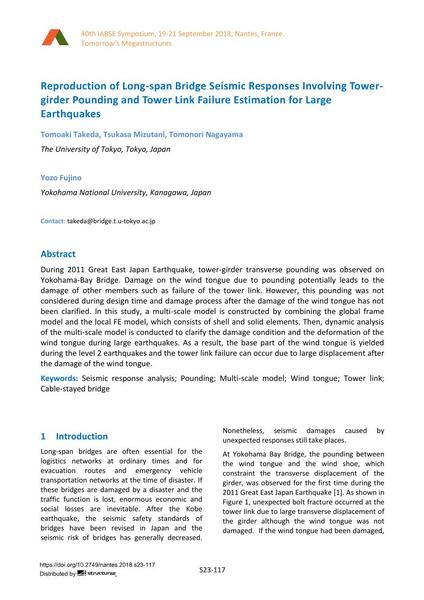Reproduction of Long-span Bridge Seismic Responses Involving Tower- girder Pounding and Tower Link Failure Estimation for Large Earthquakes

|
|
|||||||||||
Bibliographic Details
| Author(s): |
Tomoaki Takeda
(The University of Tokyo, Tokyo, Japan)
Tsukasa Mizutani (The University of Tokyo, Tokyo, Japan) Tomonori Nagayama (The University of Tokyo, Tokyo, Japan) Yozo Fujino |
||||
|---|---|---|---|---|---|
| Medium: | conference paper | ||||
| Language(s): | English | ||||
| Conference: | IABSE Symposium: Tomorrow’s Megastructures, Nantes, France, 19-21 September 2018 | ||||
| Published in: | IABSE Symposium Nantes 2018 | ||||
|
|||||
| Page(s): | S23-117 | ||||
| Total no. of pages: | 8 | ||||
| DOI: | 10.2749/nantes.2018.s23-117 | ||||
| Abstract: |
During 2011 Great East Japan Earthquake, tower-girder transverse pounding was observed on Yokohama-Bay Bridge. Damage on the wind tongue due to pounding potentially leads to the damage of other members such as failure of the tower link. However, this pounding was not considered during design time and damage process after the damage of the wind tongue has not been clarified. In this study, a multi-scale model is constructed by combining the global frame model and the local FE model, which consists of shell and solid elements. Then, dynamic analysis of the multi-scale model is conducted to clarify the damage condition and the deformation of the wind tongue during large earthquakes. As a result, the base part of the wind tongue is yielded during the level 2 earthquakes and the tower link failure can occur due to large displacement after the damage of the wind tongue. |
||||
| Keywords: |
cable-stayed bridge seismic response analysis pounding Multi-scale model Wind tongue Tower link
|
||||
